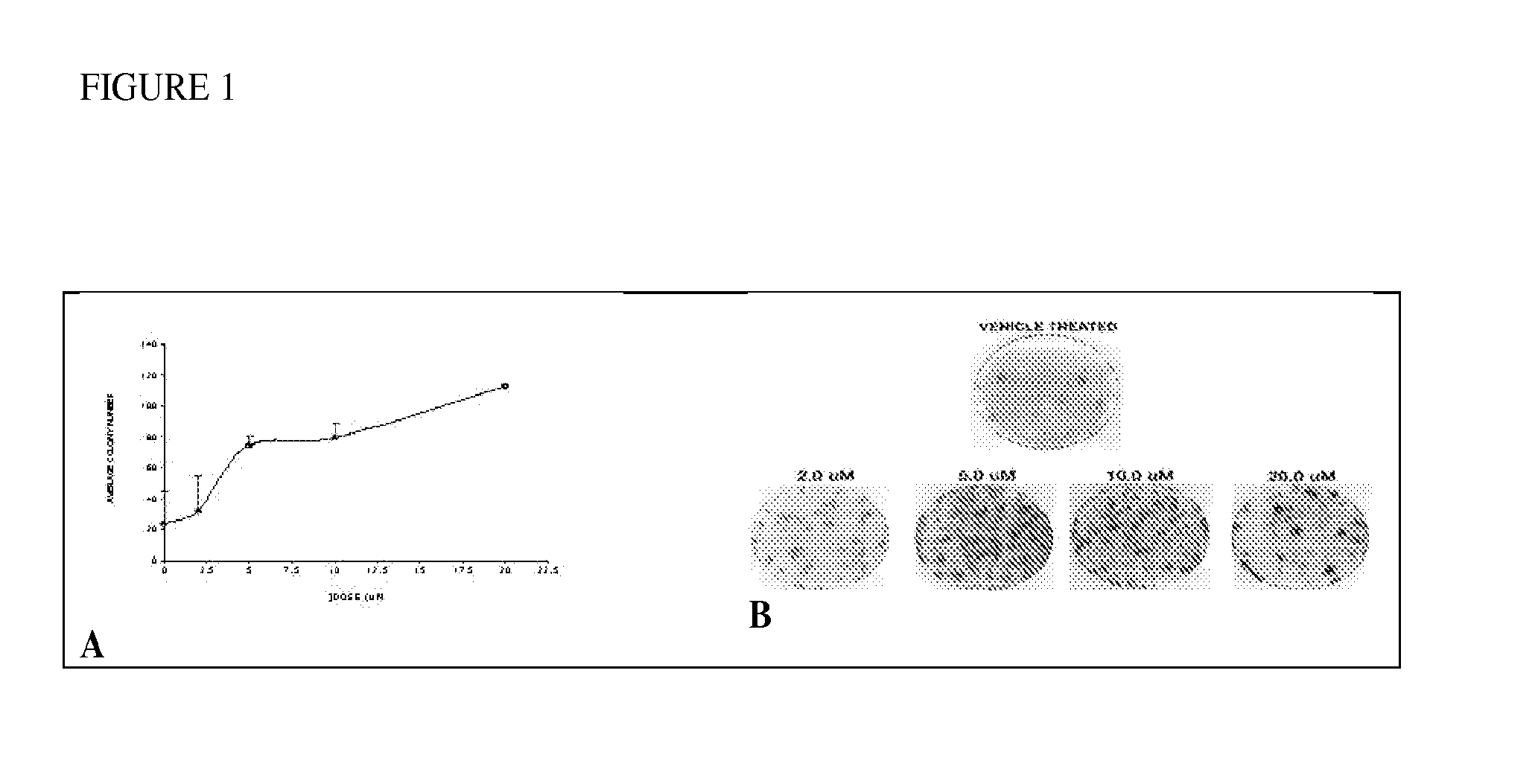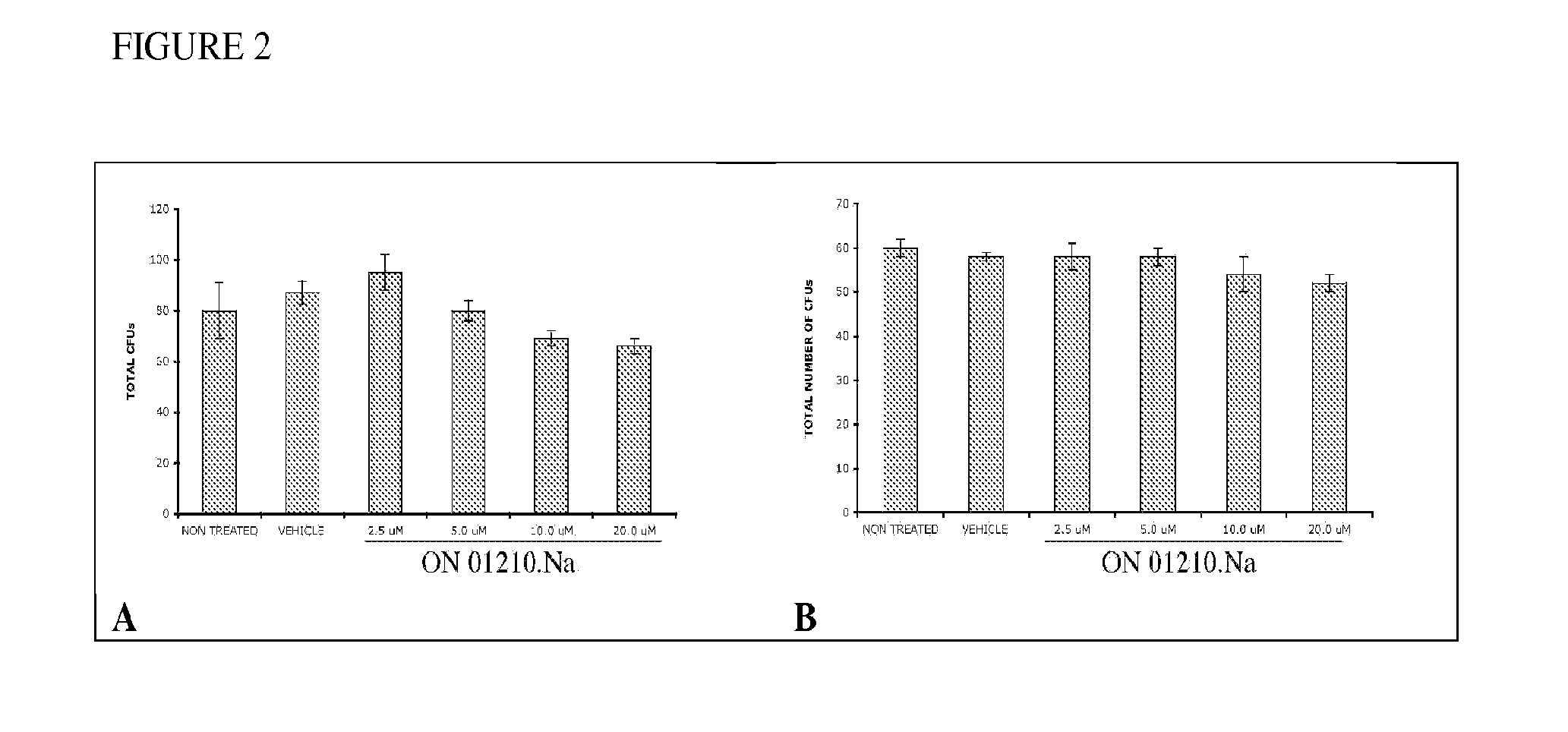Methods for determining efficacy of a therapeutic regimen against deleterious effects of cytotoxic agents in human
a cytotoxic agent and efficacy technology, applied in the field of cytotoxic agent deleterious effects of therapeutic regimens in human, can solve the problems of human subjects unwilling to enter clinical trials, unfavorable human subjects being subjected to clinical trials, and potentially fatal bleeding even from the smallest wound, so as to reduce the number of malignant cells
- Summary
- Abstract
- Description
- Claims
- Application Information
AI Technical Summary
Benefits of technology
Problems solved by technology
Method used
Image
Examples
example 1
Primary Pharmacodynamics: Dose-Dependent Radioprotection by ON 01210.Na in Normal Human Fibroblasts In Vitro
[0111]A clonogenic assay was used to measure radioprotection of ON 01210.Na on cultured human cells. Treatment of HFL-1 (normal diploid lung fibroblasts) cells with 2-20 μM of ON 01210.Na for 24 hours prior to cytotoxic levels of Ionizing Radiation (IR) (10 Gy) provided 3.3-4.7 fold protection in a dose-dependent manner (see FIG. 1A).HFL-1 cells, were treated with ON 01210.Na at final concentrations ranging from 2.0 to 20.0 μM. In a second experiment, cells were also treated with the drug for 24 h, but the drug was applied 4 h after irradiation.
[0112]FIG. 1 demonstrates protection of HFL-1 cells against IR by ON 01210.Na. Following drug treatment and radiation exposure, cells were re-plated and the number of colonies from each plate was enumerated three weeks later. A. Relation of concentration of ON 01210.Na to number of surviving colonies. B. Stained clonogenic assay plates....
example 2
In Vitro Radiation Protection of Human Bone Marrow Cells
[0114]The ability of ON 01210.Na to protect primary human bone marrow cells from cytotoxic doses of radiation was studied in an in vitro assay. Initially, cytotoxicity studies were performed. Human bone marrow cells isolated from healthy volunteers were treated with increasing concentrations of ON 01210.Na for 2 and 24 hours and plated into methocult. These studies clearly showed that ON 01210.Na treatment was non cytotoxic even at high concentrations (20 μM) over a 24 hour treatment period (FIG. 2).
[0115]Radiation protection assays were then performed (FIG. 3). Cells were treated with ON 01210.Na for 3 hours, irradiated, and plated in methocult. The total number of colony forming units was determined 14 days later. ON 01210.Na was found to protect human bone marrow cells in a dose dependent manner, with an optimal DRF of 1.6. This compared very favorably when analyzed against protection studies using amifostine as a positive c...
example 3
ON 01210.Na Protection of Murine Hematopoietic Cells (In Vivo Radiation Protection Assay)
[0119]Since survival of animals after radiation exposure depends largely on the protection of the hematopoietic system, the effect of ON 01210.Na treatment on hematopoietic cell survival was investigated using various schedules before radiation exposure. The radioprotection of hematopoietic cells by ON 01210.Na was studied in an in vivo assay using a sub lethal dose of radiation. C3H / HEJ mice were treated with ON 01210.Na following various schedules in order to determine the optimal dose and schedule of ON 01210.Na for maximum protection of the hematopoietic system in mice. Previous survival studies showed that a double injection of ON 01210.Na, minus 24 hour and minus 15 minutes, as well as a single injection at minus 15 minutes prior to lethal exposure of ionizing radiation protected 100% of the mice. The following hematopoietic studies showed that the survival studies correlated closely with ...
PUM
| Property | Measurement | Unit |
|---|---|---|
| adhesion | aaaaa | aaaaa |
| concentration | aaaaa | aaaaa |
| concentrations | aaaaa | aaaaa |
Abstract
Description
Claims
Application Information
 Login to View More
Login to View More - R&D
- Intellectual Property
- Life Sciences
- Materials
- Tech Scout
- Unparalleled Data Quality
- Higher Quality Content
- 60% Fewer Hallucinations
Browse by: Latest US Patents, China's latest patents, Technical Efficacy Thesaurus, Application Domain, Technology Topic, Popular Technical Reports.
© 2025 PatSnap. All rights reserved.Legal|Privacy policy|Modern Slavery Act Transparency Statement|Sitemap|About US| Contact US: help@patsnap.com



